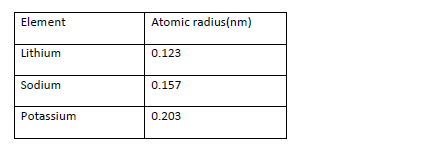 Get premium membership
Get premium membership and access questions with answers, video lessons as well as revision papers.
- Use the information in the table about group 1 elements to answer the questions that follow
Use the information in the table about group 1 elements to answer the questions that follow
 When the group 1 elements react with water, hydrogen gas is given off. The...
When the group 1 elements react with water, hydrogen gas is given off. The...
Form 2, Chemistry: The structure of the atom and the Periodic table
Date posted: March 5, 2019.
- Complete the table below to show the number of the sub-atomic particles of the given nuclides. X and Y are not actual chemical symbols.
Complete the table below to show the number of the sub-atomic particles of the given nuclides. X and Y are not actual chemical symbols.

Form 2, Chemistry: The structure of the atom and the Periodic table
Date posted: March 5, 2019.
- The table below shows the relative atomic masses and the percentage abundance of the isotopes L1 and L2 of element L.
The table below shows the relative atomic masses and the percentage abundance of the isotopes L1 and L2 of element L.
 Calculate the relative atomic mass...
Calculate the relative atomic mass...
Form 2, Chemistry: The structure of the atom and the Periodic table
Date posted: March 4, 2019.
- Balance the chemical equation given below
C3H8 + O2 ?H2O + CO2
Balance the chemical equation given below
C3H8 + O2 ?H2O + CO2
Form 2, Chemistry: Chemical Equations
Date posted: February 26, 2019.
- An atom of sodium is represented as shown below: (a) Calculate the number of neutrons in the nucleus of a sodium atom
An atom of sodium is represented as:
 a) Calculate the number of neutrons in the nucleus of a sodium atom.
b)Write the electronic configuration of a sodium atom
a) Calculate the number of neutrons in the nucleus of a sodium atom.
b)Write the electronic configuration of a sodium atom
Form 2, Chemistry: Structure of an Atom
Date posted: February 26, 2019.
- Chlorine is element number 17 in the periodic table of elements. Write down the electron configuration of its:
a) Atom
b) Ion
Chlorine is element number 17 in the periodic table of elements. Write down the electron configuration of its:
a) Atom
b) Ion
Form 2, Chemistry: Structure of an Atom
Date posted: February 26, 2019.
- Using dots (.) and crosses (x) to represent outermost electrons, draw diagrams to show bonding in.
a)Carbon (IV) oxide
b) NH4+
Using dots (.) and crosses (x) to represent outermost electrons, draw diagrams to show bonding in.
a)Carbon (IV) oxide
b) NH4+
Form 2, Chemistry: Structure and Bonding
Date posted: February 26, 2019.
- An element N forms an ion N2. This ion contains 18 electrons:
a) State the period and the group of the periodic table that element N belongs.
An element N forms an ion N2. This ion contains 18 electrons:
a) State the period and the group of the periodic table that element N belongs.
b) Write the formula of the compound which would be formed if N reacts with bromine.
Form 2, Chemistry: Structure and Bonding
Date posted: February 26, 2019.
- An element Q consists of 3 isotopes of mass 28, 29, 30 and percentage abundance of 92.2%, 4.7%, 3.1% respectively. Determine the relative atomic mass of the element?
An element Q consists of 3 isotopes of mass 28, 29, 30 and percentage abundance of 92.2%, 4.7%, 3.1% respectively. Determine the relative atomic mass of the element?
Form 2, Chemistry: Chemical Families
Date posted: February 26, 2019.